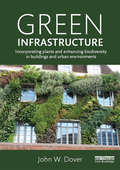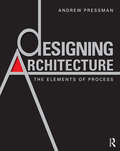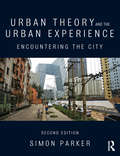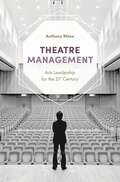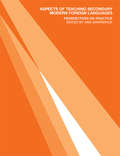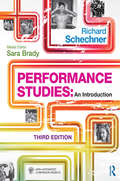- Table View
- List View
Building Services Engineering
by David V. ChaddertonEngineering services within buildings account for ongoing energy use, greenhouse gas contribution and life safety provisions. This fully updated sixth edition of David Chadderton's leading textbook is the perfect preparation for those intending to enter this increasingly important field. Chapters addressing heating, climate change, air conditioning, transportation systems, water, gas, electricity, drainage and room acoustics cover all the key responsibilities of the building services engineer. As well as introductory material and the underpinning theory, practical guidance is provided in the form of sample calculations and spreadsheets. New material includes: trends and recent applications in lowering the energy use by mechanical and electrical services systems, heating, cooling and lighting of buildings case studies modelled from post-occupancy reports to provide realistic discussion topics examples of the use of photovoltaic solar panels, chilled beams, under floor air distribution, labyrinths, ground-sourced heat pumps, district heating and cooling, energy performance certificates, energy auditing and wind turbines outlines of the concepts of global warming, carbon trading and zero carbon buildings. exercises in each chapter and online self-study questions. A significantly expanded companion site offers over 1,000 self-test questions, powerpoint slides for lecturers, and an instructors' manual, enabling the rapid generation of lectures, assignments, and tests. This is the ideal textbook for students of building services engineering, as well as a comprehensive guide for those about to start work.
Building Services Engineering
by David V. ChaddertonEngineering services within buildings account for ongoing energy use, greenhouse gas contribution and life safety provisions. This fully updated sixth edition of David Chadderton's leading textbook is the perfect preparation for those intending to enter this increasingly important field. Chapters addressing heating, climate change, air conditioning, transportation systems, water, gas, electricity, drainage and room acoustics cover all the key responsibilities of the building services engineer. As well as introductory material and the underpinning theory, practical guidance is provided in the form of sample calculations and spreadsheets. New material includes: trends and recent applications in lowering the energy use by mechanical and electrical services systems, heating, cooling and lighting of buildings case studies modelled from post-occupancy reports to provide realistic discussion topics examples of the use of photovoltaic solar panels, chilled beams, under floor air distribution, labyrinths, ground-sourced heat pumps, district heating and cooling, energy performance certificates, energy auditing and wind turbines outlines of the concepts of global warming, carbon trading and zero carbon buildings. exercises in each chapter and online self-study questions. A significantly expanded companion site offers over 1,000 self-test questions, powerpoint slides for lecturers, and an instructors' manual, enabling the rapid generation of lectures, assignments, and tests. This is the ideal textbook for students of building services engineering, as well as a comprehensive guide for those about to start work.
Green Infrastructure: Incorporating Plants and Enhancing Biodiversity in Buildings and Urban Environments (Routledge Studies in Urban Ecology)
by John W. DoverWith more than half of the world's population now living in urban areas, it is vitally important that towns and cities are healthy places to live. The principal aim of this book is to synthesize the disparate literature on the use of vegetation in the built environment and its multifunctional benefits to humans. The author reviews issues such as: contact with wildlife and its immediate and long-term effects on psychological and physical wellbeing; the role of vegetation in removing health-damaging pollutants from the air; green roofs and green walls, which provide insulation, reduce energy use and decrease the carbon footprint of buildings; and structural vegetation such as street trees, providing shading and air circulation whilst also helping to stop flash-floods through surface drainage. Examples are used throughout to illustrate the practical use of vegetation to improve the urban environment and deliver ecosystem services. Whilst the underlying theme is the value of biodiversity, the emphasis is less on existing high-value green spaces (such as nature reserves, parks and gardens), than on the sealed surfaces of urban areas (building surfaces, roads, car parks, plazas, etc.). The book shows how these, and the spaces they encapsulate, can be modified to meet current and future environmental challenges including climate change. The value of existing green space is also covered to provide a comprehensive textbook of international relevance.
Designing Architecture: The Elements of Process
by Andrew PressmanDesigning Architecture is an indispensable tool to assist both students and young architects in formulating an idea, transforming it into a building, and making effective design decisions. This book promotes integrative and critical thinking in the preliminary design of buildings to inspire creativity, innovation, and design excellence. This compendium of individual wisdom and collective experience offers explicit guidance to students and young professionals on how to approach, analyze, and execute specific tasks; develop and refine a process to facilitate the best possible design projects; and create meaningful architectural form. Here the design process – from orchestrating client participation to finalizing schematic design – is explored and illuminated. The following material is presented to make the book a useful didactic tool for professional development: explicit strategies for doing design rather than simply reviewing principles and precedents creative ideas in approaching and framing problems in design terms specific methods to translate ideas to culturally significant, socially responsive, and environmentally sensitive buildings techniques to integrate all levels of cognition from analysis to epiphany counsel on developing a personalized process for engaging design projects case studies augment the text and chronicle fascinating applications of the design process. The essence of this book lies in an integrated and holistic approach to each unique project as well as fostering curiosity and exploration – a departure from algorithms, easy generalities, or a formula for design. Designing Architecture will inspire readers to elevate the quality of preliminary designs and unravel some of the mystery of creating the most beautiful, responsive, and responsible architectural design possible.
Urban Theory and the Urban Experience: Encountering the City
by Simon ParkerUrban Theory and the Urban Experience brings together classic and contemporary approaches to urban research in order to reveal the intellectual origins of urban studies and the often unacknowledged debt that empirical and theoretical perspectives on the city owe one another. From the foundations of modern urban theory in the work of Weber, Simmel, Benjamin and Lefebbvre to the writings of contemporary urban theorists such as David Harvey and Manuel Castells and the Los Angeles school of urbanism, Urban Theory and the Urban Experience traces the key developments in the idea of the city over more than a century. Individual chapters explore investigative studies of the great metropolis from Charles Booth to the contemporary urban research of William J. Wilson, along with alternative approaches to the industrial city, ranging from the Garden City Movement to ‘the new urbanism’. The volume also considers the impact of new information and communication technologies, and the growing trend towards disaggregated urban networks, all of which raise important questions about viability and physical and social identity of the conventional townscape. Urban Theory and the Urban Experience concludes with a rallying cry for a more holistic and integrated approach to the urban question in theory and in practice if the rich potent. For the benefit of students and tutors, frequent question points encourage exploration of key themes, and annotated further readings provide follow-up sources for the issues raised in each chapter. The book will be of interest to students, scholars, practitioners and all those who wish to learn more about why the urban has become the dominant social, economic and cultural form of the twenty-first century
Theatre Management: Arts Leadership for the 21st Century
by Anthony RhineAn essential introductory textbook that provides a comprehensive and student-friendly overview of the key processes involved in developing and managing a theatre in the 21st century. It covers a complete range of topics fundamental to successful commercial and not-for-profit theatre management, from developing a mission statement to communicating with stakeholders, from marketing and promotion to fund development platforms, and from governance structures to community engagement. With over two decades of experience in the industry, Anthony Rhine encourages a critical understanding of theatre management; rather than simply giving students the facts and theories to memorise, he shows readers how to think like theatre managers, giving them the skills needed to be able to carve out their own career paths. Far-reaching and globally applicable, the text serves as an invaluable guide for aspiring theatre managers, as well as undergraduate and postgraduate students on Theatre Management, Arts Management, Creative Industries and Theatre and Performance Studies degree courses.
Japanese Cinema Between Frames
by Laura LeeThis book explores the rich complexity of Japan’s film history by tracing how cinema has been continually reshaped through its dynamic engagement within a shifting media ecology. Focusing on techniques that draw attention to the interval between frames on the filmstrip, something that is generally obscured in narrative film, Lee uncovers a chief mechanism by which, from its earliest period, the medium has capitalized on its materiality to instantiate its contemporaneity. In doing so, cinema has bound itself tightly with adjacent visual forms such as anime and manga to redefine itself across its history of interaction with new media, including television, video, and digital formats. Japanese Cinema Between Frames is a bold examination of Japanese film aesthetics that reframes the nation’s cinema history, illuminating processes that have both contributed to the unique texture of Japanese films and yoked the nation’s cinema to the global sphere of film history.
Planning Under Pressure
by John Friend Allen HicklingPlanning under Pressure offers managers, planners, consultants and students a comprehensive and authoritative guide to the Strategic Choice Approach, which has gradually been attracting worldwide recognition as a fresh, versatile and practical approach to collaborative decision-making under uncertainty. Starting from basic principles, the book uses helpful diagrams and clear explanations to demonstrate practical ways of approaching daunting decision problems; of devising possible ways forward; and of working effectively towards agreed courses of action. Along he way, decision makers are helped to cope with diverse sources of uncertainty – technical, political, managerial – in a strategic manner.In this extended third edition, the authors have added short contributions from 21 users from seven countries. These new contributors present lessons from their varied experiences in adapting the Strategic Choice Approach to guide decision-making and learning in settings ranging from the re-routing of a controversial city carnival procession to national policy for the management of nuclear waste.
Planning Under Pressure
by John Friend Allen HicklingPlanning under Pressure offers managers, planners, consultants and students a comprehensive and authoritative guide to the Strategic Choice Approach, which has gradually been attracting worldwide recognition as a fresh, versatile and practical approach to collaborative decision-making under uncertainty. Starting from basic principles, the book uses helpful diagrams and clear explanations to demonstrate practical ways of approaching daunting decision problems; of devising possible ways forward; and of working effectively towards agreed courses of action. Along he way, decision makers are helped to cope with diverse sources of uncertainty – technical, political, managerial – in a strategic manner.In this extended third edition, the authors have added short contributions from 21 users from seven countries. These new contributors present lessons from their varied experiences in adapting the Strategic Choice Approach to guide decision-making and learning in settings ranging from the re-routing of a controversial city carnival procession to national policy for the management of nuclear waste.
Managing World Heritage Sites
by Anna Leask Alan FyallWorld Heritage Sites are some of the most recognised locations around the world. They include natural sites such as the Grand Canyon and the Great Barrier and cultural ones such as the Pyramids at Giza, the Walled City of Baku in Azerbaijan and the Historic Centre of Riga in Latvia. The responsibility to manage them successfully and ensure that the resources are not damaged by visitors, war or environment is therefore vital. Managing World Heritage Sites covers the management issues encountered at cultural and natural UNESCO World Heritage Sites). WHS sites are high profile and as their designation states they are unique. They are often government owned and subject to political debate, they have iconic status and are therefore crucial to national tourism industries, and often involve a large number of stakeholders within their management structures. This text considers all of these aspects in arriving at solutions for site management principles. In 12 chapters and 5 case studies it covers issues such as WHS designation, marketing, visitor management, revenue generation and management. Each chapter will examine the management issues associated with managing heritage within the WH Sites, making clear use of management practices to apply the theory. Managing World Heritage Sites: • Includes international case studies such as World Heritage Sites in the Americas, Machupicchu, Stonehenge, Central Eastern Rainforest Reserves of Australia, Megalithic Temples of Malta.• Is authored by an international contributor team of well known and respected experts in this field • Has a user friendly and logical structure including aims, introduction, case study, conclusion, references and websites and examples best practice. • 5 specific case study chapters including a location map, an explanation of key issues, conclusion, and questions for self-study
Managing World Heritage Sites
by Anna Leask Alan FyallWorld Heritage Sites are some of the most recognised locations around the world. They include natural sites such as the Grand Canyon and the Great Barrier and cultural ones such as the Pyramids at Giza, the Walled City of Baku in Azerbaijan and the Historic Centre of Riga in Latvia. The responsibility to manage them successfully and ensure that the resources are not damaged by visitors, war or environment is therefore vital. Managing World Heritage Sites covers the management issues encountered at cultural and natural UNESCO World Heritage Sites). WHS sites are high profile and as their designation states they are unique. They are often government owned and subject to political debate, they have iconic status and are therefore crucial to national tourism industries, and often involve a large number of stakeholders within their management structures. This text considers all of these aspects in arriving at solutions for site management principles. In 12 chapters and 5 case studies it covers issues such as WHS designation, marketing, visitor management, revenue generation and management. Each chapter will examine the management issues associated with managing heritage within the WH Sites, making clear use of management practices to apply the theory. Managing World Heritage Sites: • Includes international case studies such as World Heritage Sites in the Americas, Machupicchu, Stonehenge, Central Eastern Rainforest Reserves of Australia, Megalithic Temples of Malta.• Is authored by an international contributor team of well known and respected experts in this field • Has a user friendly and logical structure including aims, introduction, case study, conclusion, references and websites and examples best practice. • 5 specific case study chapters including a location map, an explanation of key issues, conclusion, and questions for self-study
Aspects of Teaching Secondary Modern Foreign Languages: Perspectives on Practice
by Ann SwarbrickThis lively and inspiring collection of readings is divided into three sections: 'Developing teaching strategies and effective classroom management' covers all major aspects of classroom practice; 'Planning, evaluating and assessing MFL learning' is a guide to the day to day requirements and practicalities of MFL teaching; 'In search of a wider perspective' considers how MFL teaching might develop and expand, and its place outside the classroom. Fully engaged with teaching and learning MFL at a practical level, it illustrates concepts and good practice through a braod range of classroom-based examples and case studies.Issues covered in this book include: maximising potential engaging pupils in their learning developing listening, reading and oral skills use of information communication technology assessment and differentiation broadening the content of MFL lessons role play in the language class MFL beyond the classroom.
Aspects of Teaching Secondary Modern Foreign Languages: Perspectives on Practice
by Ann SwarbrickThis lively and inspiring collection of readings is divided into three sections: 'Developing teaching strategies and effective classroom management' covers all major aspects of classroom practice; 'Planning, evaluating and assessing MFL learning' is a guide to the day to day requirements and practicalities of MFL teaching; 'In search of a wider perspective' considers how MFL teaching might develop and expand, and its place outside the classroom. Fully engaged with teaching and learning MFL at a practical level, it illustrates concepts and good practice through a braod range of classroom-based examples and case studies.Issues covered in this book include: maximising potential engaging pupils in their learning developing listening, reading and oral skills use of information communication technology assessment and differentiation broadening the content of MFL lessons role play in the language class MFL beyond the classroom.
City Spaces - Tourist Places
by Bruce Hayllar Tony Griffin Deborah EdwardsOver the last decade, commentaries and research on urban tourism precincts have predominantly focused on: their role in the tourism attractions mix; their physical and functional forms; their economic significance; their role as a catalyst for urban renewal; their evolution and associated development processes; and, perhaps more broadly, their role, locality and function within the context of urban planning. City Spaces – Tourist Places both consolidates and develops the extant knowledge of urban tourism precincts into a coherent research driven contemporary work. It revisits and examines the foundational literature but, more importantly, engages with aspects of precinct development that have previously been either underdeveloped or received only limited consideration, such as the psychological and socio-cultural dimensions of the precinct experience. Written by an international team of contributors it provides the reader with:* A comprehensive analysis of foundational theory and cutting-edge advances in the knowledge of the precinct phenomenon * An examination of previously underdeveloped topics and themes based on contemporary and ground-breaking research * Typological and theoretical frameworks in which to locate precinct form, function and experienceBrilliantly edited to ensure theoretical continuity and coherence City Spaces – Tourist Places is vital reading for anyone involved in the study or planning of urban tourism precincts.
City Spaces - Tourist Places
by Bruce Hayllar Tony Griffin Deborah EdwardsOver the last decade, commentaries and research on urban tourism precincts have predominantly focused on: their role in the tourism attractions mix; their physical and functional forms; their economic significance; their role as a catalyst for urban renewal; their evolution and associated development processes; and, perhaps more broadly, their role, locality and function within the context of urban planning. City Spaces – Tourist Places both consolidates and develops the extant knowledge of urban tourism precincts into a coherent research driven contemporary work. It revisits and examines the foundational literature but, more importantly, engages with aspects of precinct development that have previously been either underdeveloped or received only limited consideration, such as the psychological and socio-cultural dimensions of the precinct experience. Written by an international team of contributors it provides the reader with:* A comprehensive analysis of foundational theory and cutting-edge advances in the knowledge of the precinct phenomenon * An examination of previously underdeveloped topics and themes based on contemporary and ground-breaking research * Typological and theoretical frameworks in which to locate precinct form, function and experienceBrilliantly edited to ensure theoretical continuity and coherence City Spaces – Tourist Places is vital reading for anyone involved in the study or planning of urban tourism precincts.
Galbraith's Building and Land Management Law for Students
by Michael Stockdale Rebecca Mitchell Stephen Wilson Simon Spurgeon Russell Hewitson Mick WoodleyIdeal for first year Undergraduate students taking law modules on Construction, Surveying, Planning and Engineering courses, Galbraith’s Building and Land Management Law for Students is an excellent overview of the key legal issues in the construction industry. Clearly written and wide ranging coverage of key legal principles by construction lecturers and professionals, this textbook highlights the need for students on construction related courses to access information on how the law relates to them, without getting into the dry, heavy detail of the full scale legal texts. This sixth edition has been fully updated and covers the latest JCT Standard Form Building Contract requirements and key EU directives, including Corporate Manslaughter, Employment Law, Tenant Planning Law regulations and Health and Safety acts.
Paris in the Cinema: Beyond the Flâneur
by Ginette Vincendeau Alastair PhillipsParis is the most iconic and frequently painted, photographed and filmed city in the world. Paris in the Cinema: Beyond the Flâneur offers a new approach to the representation of Paris on screen. Bringing together a wide range of renowned French and Anglophone specialists in film, history, architecture and literature, Alastair Phillips and Ginette Vincendeau introduce, challenge and extend ideas about the city as the locus of screen modernity. Through a range of concrete and historically-specific case studies, this vibrant collection: • provides innovative angles on how films deploy the French capital beyond its function as glamorous background• explores how filmmakers both construct and recycle its status as an ‘iconic capital’ • considers the specific identities of Parisians on screen• demonstrates how the cinematic city of Paris now constitutes a major archive of French cultural history and memory. Fresh and engaging, this fascinating resource will appeal to all students, scholars and lovers of French cinema and the capital city that comprises its major home.
Galbraith's Building and Land Management Law for Students
by Michael Stockdale Rebecca Mitchell Stephen Wilson Simon Spurgeon Russell Hewitson Mick WoodleyIdeal for first year Undergraduate students taking law modules on Construction, Surveying, Planning and Engineering courses, Galbraith’s Building and Land Management Law for Students is an excellent overview of the key legal issues in the construction industry. Clearly written and wide ranging coverage of key legal principles by construction lecturers and professionals, this textbook highlights the need for students on construction related courses to access information on how the law relates to them, without getting into the dry, heavy detail of the full scale legal texts. This sixth edition has been fully updated and covers the latest JCT Standard Form Building Contract requirements and key EU directives, including Corporate Manslaughter, Employment Law, Tenant Planning Law regulations and Health and Safety acts.
Regenerating London: Governance, Sustainability and Community (PDF)
by Robert Imrie Loretta Lees Mike Raco Rob ImrieRegenerating London explores latest thinking on urban regeneration in one of the fastest changing world cities. Engaging with social, economic, and political structures of cities, it highlights paradoxes and contradictions in urban policy and offers an evaluation of the contemporary forms of urban redevelopment.
Performance Studies: An Introduction
by Richard SchechnerThe publication of Performance Studies: An Introduction was a defining moment for the field. Richard Schechner's pioneering textbook provides a lively and accessible overview of the full range of performance for undergraduates at all levels and beginning graduate students in performance studies, theatre, performing arts, and cultural studies. Among the topics discussed are the performing arts and popular entertainments, rituals, play and games, and the performances of everyday life. Supporting examples and ideas are drawn from the social sciences, performing arts, poststructuralism, ritual theory, ethology, philosophy, and aesthetics. This third edition is accompanied by an all-new companion website curated by a dedicated media editor, with the following resources for instructors and students: Interactive glossary Multiple choice questions Powerpoint Slides. Videos Website links for further study Tutorials on specific skills within Performance Studies Sample Discussion Questions Exercises and Activities Sample Syllabi The book itself has also been revised, with 25 new extracts and biographies, up-to-date coverage of global and intercultural performances, and further exploration of the growing international presence of Performance Studies as a discipline. Performance Studies is the definitive overview for undergraduates, with primary extracts, student activities, key biographies and over 200 images of global performance.
Performance Studies: An Introduction
by Richard SchechnerThe publication of Performance Studies: An Introduction was a defining moment for the field. Richard Schechner's pioneering textbook provides a lively and accessible overview of the full range of performance for undergraduates at all levels and beginning graduate students in performance studies, theatre, performing arts, and cultural studies. Among the topics discussed are the performing arts and popular entertainments, rituals, play and games, and the performances of everyday life. Supporting examples and ideas are drawn from the social sciences, performing arts, poststructuralism, ritual theory, ethology, philosophy, and aesthetics. This third edition is accompanied by an all-new companion website curated by a dedicated media editor, with the following resources for instructors and students: Interactive glossary Multiple choice questions Powerpoint Slides. Videos Website links for further study Tutorials on specific skills within Performance Studies Sample Discussion Questions Exercises and Activities Sample Syllabi The book itself has also been revised, with 25 new extracts and biographies, up-to-date coverage of global and intercultural performances, and further exploration of the growing international presence of Performance Studies as a discipline. Performance Studies is the definitive overview for undergraduates, with primary extracts, student activities, key biographies and over 200 images of global performance.
The Expressive Actor: Integrated Voice, Movement and Acting Training
by Michael Lugering"The study of acting should not begin with an exploration of feeling, perception, imagination, memories, intention, personalization, self-identification... or even performance—but physical action." Michael Lugering's The Expressive Actor presents a foundational, preparatory training method, using movement to unlock the entire acting process. Its action-based perspective integrates voice, movement and basic acting training into a unified approach. A wealth of exercises and diagrams guide the reader through this internationally taught program, making it an ideal step-by-step course for both solo and classroom use. Through this course, voice and body training becomes more than a simple skill-building activity – it is the central prerequisite to any actor training. This new Routledge edition has been fully updated, to include: A revised prologue, further discussing the historical and philosophical grounding of The Lugering Method A new introduction, with particular focus on the integrative nature of the method and how the book should be used. New developments, clarifications, and 12 new exercises. 6 new illustrative diagrams.
The Expressive Actor: Integrated Voice, Movement and Acting Training
by Michael Lugering"The study of acting should not begin with an exploration of feeling, perception, imagination, memories, intention, personalization, self-identification... or even performance—but physical action." Michael Lugering's The Expressive Actor presents a foundational, preparatory training method, using movement to unlock the entire acting process. Its action-based perspective integrates voice, movement and basic acting training into a unified approach. A wealth of exercises and diagrams guide the reader through this internationally taught program, making it an ideal step-by-step course for both solo and classroom use. Through this course, voice and body training becomes more than a simple skill-building activity – it is the central prerequisite to any actor training. This new Routledge edition has been fully updated, to include: A revised prologue, further discussing the historical and philosophical grounding of The Lugering Method A new introduction, with particular focus on the integrative nature of the method and how the book should be used. New developments, clarifications, and 12 new exercises. 6 new illustrative diagrams.
Theatre in Practice: A Student's Handbook
by Nick O'Brien Annie SuttonTheatre in Practice provides students with all of the ‘must have’ Drama skills required for A-Level, International Baccalaureate, BTEC and beyond. Practical, step-by-step exercises and diagrams give access to the key figures and processes central to drama, including: Stanislavski, Brecht, Lecoq and Berkoff devising theatre rehearsing and performing monologues and duologues how to approach directing a play improvising. Each chapter offers advice for both students and teachers, with notes and follow-on exercises ideal for individual study and practice. Written by specialists with extensive experience leading workshops for the 'post 16' age-group, Theatre in Practice is a thorough and imaginative resource that speaks directly to students.
Theatre in Practice: A Student's Handbook
by Nick O'Brien Annie SuttonTheatre in Practice provides students with all of the ‘must have’ Drama skills required for A-Level, International Baccalaureate, BTEC and beyond. Practical, step-by-step exercises and diagrams give access to the key figures and processes central to drama, including: Stanislavski, Brecht, Lecoq and Berkoff devising theatre rehearsing and performing monologues and duologues how to approach directing a play improvising. Each chapter offers advice for both students and teachers, with notes and follow-on exercises ideal for individual study and practice. Written by specialists with extensive experience leading workshops for the 'post 16' age-group, Theatre in Practice is a thorough and imaginative resource that speaks directly to students.

